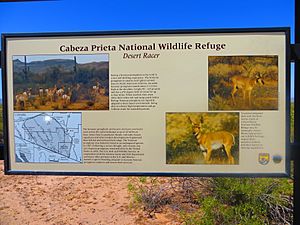Sonoran pronghorn facts for kids
Quick facts for kids Sonoran pronghorn |
|
|---|---|
| Conservation status | |
| Scientific classification |
|
| Kingdom: | Animalia |
| Phylum: | Chordata |
| Class: | Mammalia |
| Order: | Artiodactyla |
| Family: | Antilocapridae |
| Genus: | Antilocapra |
| Species: | |
| Subspecies: |
A. a. sonoriensis
|
| Trinomial name | |
| Antilocapra americana sonoriensis Goldman, 1945
|
|

The Sonoran pronghorn (Antilocapra americana sonoriensis) is a special type of pronghorn. It is an endangered animal that lives only in the Sonoran Desert. This means it is found nowhere else in the world.
Contents
Protecting the Sonoran Pronghorn
Scientists believe there are about 200 Sonoran pronghorns in the United States today. This is a good improvement from 2002, when only about 21 were left. The number of these animals in Mexico is thought to be even lower.
In 2012, plans were made to bring more pronghorns back to certain areas. One plan was for the Barry M. Goldwater Air Force Range (BMGR) in Yuma, Arizona. Another plan was for the Kofa National Wildlife Refuge. These efforts help increase their numbers.
Challenges to Their Survival
Many things make it hard for the Sonoran pronghorn to survive. A big challenge is that much of their home is on the BMGR. This area is an active United States Air Force bombing range. This can disturb the animals.
Next to the BMGR is the Cabeza Prieta National Wildlife Refuge (CPNWR). This refuge is a very important place for pronghorns to have their babies. Parts of the CPNWR are closed to visitors from mid-March to mid-July. This is during the fawning season, when baby pronghorns are born. Closing these areas helps keep the new families safe. Even with these protections, the area still faces environmental challenges.
Why Pronghorns Die
Pronghorns live in open areas. They use their excellent eyesight to spot dangers and avoid predators. Because there are so few Sonoran pronghorns, it's very important that they stay safe.
Pronghorns can die from predators, dry weather (drought), or not enough food. Baby pronghorns, called fawns, are most often affected. Adult pronghorns can also die during droughts. It is hard to control drought because it depends on the weather. Scientists are studying if controlling predators like coyotes and bobcats could help.
Where They Live and What They Eat
The Sonoran pronghorn lives only in the Sonoran Desert. They like open spaces. They mainly eat grasses and shrubs. These desert pronghorns are very good at living in dry conditions. They can go for longer periods without needing to drink water.
See also
 In Spanish: Berrendo de Sonora para niños
In Spanish: Berrendo de Sonora para niños


